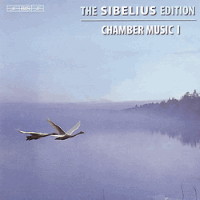
A Broader Canvas
Chamber music
by Sibelius -
enjoyed by
ROBERT ANDERSON'... fresh and unfamiliar music, put across with such conviction ...'
|

|
Like all the best families, including my own, the Sibbe children were brought up to play chamber music, forming their own piano trio with Jean as violinist. It was their grandfather who followed the Finnish craze to turn their surnames into pseudo-Latin as Sibelius, in much the same way as a Reformation hero such as Schwarzerd has come down in history as a would-be ancient Greek boasting the name Melanchthon. Just as Elgar provided music for the Brothers Wind in his early days as a bassoonist, so did Sibelius keep the family out of mischief by composing steadily for home consumption. There are more than forty pieces on these six discs, and all but seven date from the 1880s, before Sibelius was twenty-five.
String quartets predominate in these discs, due perhaps less to family reasons than to the magnificent corpus of works left behind by Haydn, Mozart, Beethoven, and Schubert. If Sibelian fingerprints are not always apparent, technical competence testifies to careful study of the Classics and melodic resource occasionally has an individual twist. The Molto moderato-Scherzo, written when Sibelius was nearing the end of his teens, has a frisky charm and rhythmic drive that are themselves attractive and hint at orchestral pieces yet to come.
Listen -- Sibelius: Molto moderato -- Scherzo (JS 134)
(CD 1 track 1, 0:02-1:29) © 2003-7 BIS Records AB
The most important of Sibelius's early teachers was Martin Wegelius, another pretended citizen of imperial Rome, who founded the Helsinki music institute in 1882. He wrote a notable account of Wagner's career, and would have made of Sibelius an equally ardent devotee with perhaps an eventual catalogue of operas to his credit. Certainly Wagnerian influence hovered round Sibelius's music as far as the Finlandia of 1900. It is to the credit of Wegelius that his recognition of Sibelius's gifts secured for him much-needed financial backing, but his reward was a particularly gritty and relentless fugue, originally intended as finale to the A minor quartet of 1889.
Listen -- Sibelius: Fuga för Martin Wegelius (JS 85)
(CD 2 track 6, 0:02-1:14) © 2003-7 BIS Records AB
In Berlin for further instruction from Albert Becker from autumn 1889, Sibelius's lessons were less important than his listening. It was his first experience of a great European capital. He heard Don Giovanni and Die Meistersinger for the first time, and could increase his chamber music knowledge through the concerts of the Joachim Quartet, still on top form. The result was composition of the first string quartet to which he gave an opus number. In B flat, his Op 4 is real quartet writing, with exciting interplay among the parts, and a subtle use of silence as telling musical ingredient.
Listen -- Sibelius: Allegro (String Quartet in B flat Op 4)
(CD 3 track 2, 0:00-1:46) © 2003-7 BIS Records AB
Returning to Sibelius's days as a self-taught composer, the opening movement of the Piano Trio in A minor shows him experimenting in 1884 for the first time with sonata form. His sense of drama, so essential to the sonata principle, is already well developed.
Listen -- Sibelius: Allegro con brio (Piano Trio in A minor JS 206)
(CD 4 track 7, 0:00-1:47) © 2003-7 BIS Records AB
Far more entertaining is the brief piece Sibelius wrote for piano trio in 1891 entitled La pompeuse marche d'Asis. The last word is an acronym for the Anatomical Institute of Helsinki University, where his brother Christian was studying. The piece was a huge success, encored three times, and inspired many a bumper drunk to Sibelius's health.
Listen -- Sibelius: La pompeuse March d'Asis (JS 116)
(CD 5 track 11, 0:02-1:06) © 2003-7 BIS Records AB
If the opening, slightly oriental, is comparatively staid, the end is not.
The most tantalising group of pieces in the set is scored for violin, cello, and piano four hands. These are half a dozen attempts towards an opera to be called Ljunga Wirginia. The libretto was to be by Walter von Konow, a Sibelius friend from his boyhood, with whom he used to make up fantastic tales to be illustrated from the piano. This was clearly their most ambitious effort to date. The music was written in August 1885, but nothing of the libretto survives, so it is impossible to know the work's subject. Before any contact with Wegelius, Sibelius shows himself writing as if on a broader canvas.
Listen -- Sibelius: Prestissimo (Ljunga Wirginia)
(CD 6 track 6, 0:42-1:46) © 2003-7 BIS Records AB
What a joy it has been to hear so much fresh and unfamiliar music, put across with such conviction by the various teams.
Copyright © 14 January 2009
Robert Anderson, Cairo, Egypt
 BUY CLASSICAL CDS ONLINE
CD INFORMATION: THE SIBELIUS EDITION - CHAMBER MUSIC 1
BUY CLASSICAL CDS ONLINE
CD INFORMATION: THE SIBELIUS EDITION - CHAMBER MUSIC 1
| 
